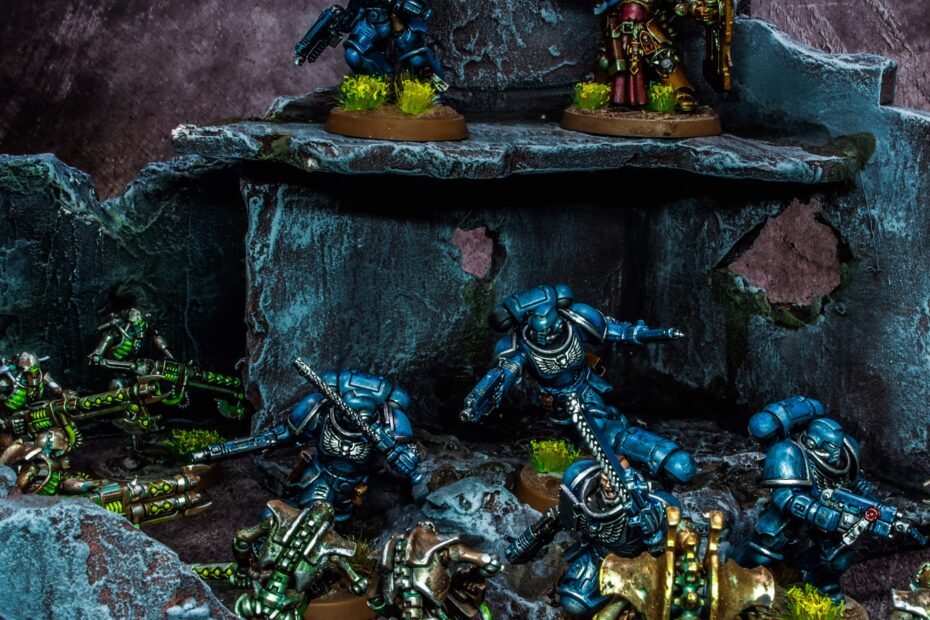However you stumble into the hobby, it can be daunting. Not knowing where to start can put a lot of people off. So I’ve prepared this guide to help novice tabletop gamers.
Of course, you can always skip this and just come ask your local groups on Facebook or Discord.
Choosing a Faction
If this is your first army. Go with the rule of cool. Pick what speaks most to you. Big stompy robots. Angry space marines. Demons and Monsters. Alien Swarms. They all play differently, but you do you. Go with whatever excites you most.
Building a List
List building can be daunting. If you already have some models. Start with them and then expand outwards. If you are starting from scratch, great value can be found in Start Collecting, Combat Patrol, or other Army boxes.
See the Useful Links page for where to find out more to help guide your decisions.
- Battlescribe is your best bet, but can be a little daunting to get started with.
- The official Battle Forge tool can be subscribed as part of the Warhammer 40k App from Games Workshop, but this still relatively new and far less user friendly.
- Pen & Paper
- A spreadsheet
NOTE: The key things to remember with any list building tool. First you pick your faction, your detachment(s), sub-factions, and battle size.
Then start adding units, consult your codex for Wahapedia or guidance, and correct any mistakes the list builder flags.
For more on building your first list, see Building your First Army for Warhammer 40k.
Assembling an Army
Once you’ve got a list, it’s time to start collecting and assembling the models and units.
See this Useful Links page for recommendations of where to buy models and kits.
NOTE: Don’t forget to try the local club members, Facebook, and eBay first for great second hand deals on models and books. You might even be able to get a ready built and painted army for cheap and start playing immediately.
Building the models is just a case of following the step-by-step instructions provided.

- Use flush cutters and a hobby knife to remove them from the sprue and clean up any joins and mould lines.
- Glue plastic models with Polystyrene cement, and anything else with Super Glue.
- Look for any specific instructions related to options and loadouts. It’s always best to try to make models WYSIWYG (What You See Is What You Get). i.e. To have the equipment you are playing them with visible.
Painting and Basing
The usual rule here is paint is optional. No one will judge you if you field grey plastic or primed minis. Offical games Workshop scoring includes 10 points for being “Tabletop Ready” but this is itself subject to interpreation.
- Apply a layer of primer. You can do this by Spray Can, Airbrush, or Brush. Primer helps the paint to go down evenly, but is not essential.
- Basecoat the key parts of the model. This just means blocking out each thing on the model in a suitable colour.
- Thin your paints by mixing the paint with a little water on a palette. This will allow you to get smoother coats (dropper bottles are better than pots for doing this)
- Apply two or more thinned coats. Always allow time for the previous layer to dry first.
- Dry brushing can quickly provide highlights and used carefully is a great tool to quickly level up a paint job.
- Applying a wash like Nuln Oil and Agrax Earthshade can quickly give a basic base coat depth and shadows and for this reason are sometimes referred to as liquid talent.
- If you feel fancy, you can try applying further highlights and building on these basic techniques.
Here are some useful videos to get you up to speed fast:
- Goobertown Hobbies: Fundamentals
- Midwinter Minis: Speedpainting Guides
- Dana Howl: Hobby Basics
- Sonic Sledgehammer: How I Paint Things
- Pete the Wargamer: How to Paint…
Learning the Rules
There’s a lot to read up on before you play. In general though, they break down into 3 key areas:
- Core game rules and updates
- Faction codexes
- Community resources
Here are some links to get you started:
- A PDF of the core rules is available to download (the book can also be purchased along with Grand Tournament updates for competitive play once per year)
- Your faction codex can be bought but a lot of information is available online on sites like Wahapedia
- Getting started guides / faction breakdowns on Goonhammer or Youtube
- The offical index of FAQs
Playing an Introduction Game
Local clubs and players are usually happy to play an intro game with anyone looking to get into 40k, Kill Team, Age of Sigmar, or many other games. Even if you are a returning gamer from a previous edition, looking to brush up and get clued in to the current edition.
What Should You Bring
To play a game you will find the following useful:
- Your army. Ideally in a box or case, protected with foam, magnetised, or wrapped in bubble wrap.
- Your army list.
- A tape measure.
- Some dice. Usually this means 10 or more 6-sided dice. This type of dice is commonly called a D6.
- Any rules you might want to refer to.
Getting Better
Playing more games and introducing the additional rules and complexity is the best way forward. As you gain experience you will find you can get a couple of 800pt games into an evening.
Talking to your opponents and club members will also help you level up fast. Collectively a club is a great resource with broad and deep knowledge on the game and it’s factions.
Watching battle reports, YouTube guides, and Warhammer articles can help your understanding and give you new ideas.
